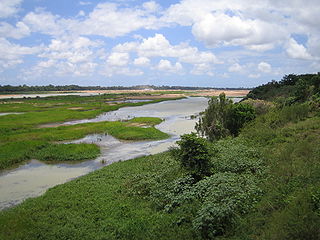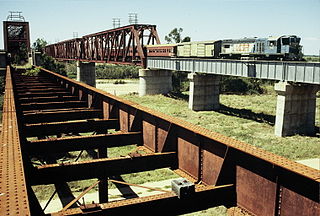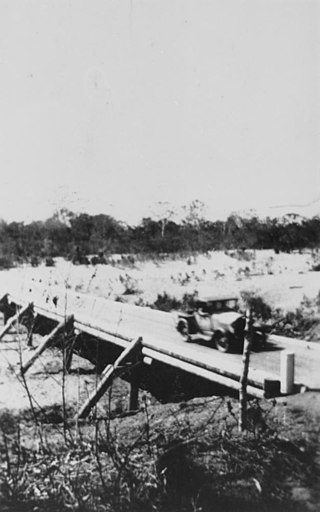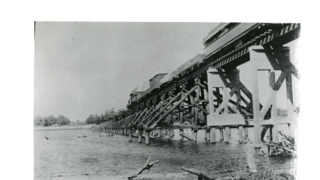
Albert Bridge is a heritage-listed railway bridge of steel truss design crossing the Brisbane River between Indooroopilly and Chelmer in the City of Brisbane, Queensland, Australia. It was designed by Henry Charles Stanley and built from 1894 to 1895 by John McCormick & Son as a replacement for an earlier bridge lost to flooding in 1893. Both bridges were named in honour of the Prince of Wales, Prince Albert. It was added to the Queensland Heritage Register on 21 October 1992.

The Shire of Burdekin is a local government area located in North Queensland, Australia in the Dry Tropics region. The district is located between Townsville and Bowen in the delta of the Burdekin River. The shire covers an area of 5,044 square kilometres (1,947 sq mi). It has existed as a local government entity since 1888. In the 2021 census, the Shire of Burdekin had a population of 16,692 people.

The Burdekin River is a river in North and Far North Queensland, Australia. The river rises on the northern slopes of Boulder Mountain at Valley of Lagoons, part of the western slope of the Seaview Range, and flows into the Coral Sea at Upstart Bay over 200 kilometres (124 mi) to the southeast of the source, with a catchment area of approximately 130,000 square kilometres (50,000 sq mi). The Burdekin River is Australia's largest river by (peak) discharge volume.

Ayr is a rural town and locality in the Shire of Burdekin, Queensland, Australia. It is the centre of a sugarcane-growing region and the administrative centre for the Burdekin Shire Council. In the 2021 census, the locality of Ayr had a population of 8,603 people.

The Barkly Highway is a national highway in Queensland and the Northern Territory in Australia. It is the only sealed road between Queensland and the Northern Territory. The highway is named after the Barkly Tableland, which in turn was named by explorer William Landsborough in December 1861 after Henry Barkly, the then Governor of Victoria.

Home Hill is a rural town and locality in the Shire of Burdekin, Queensland, Australia. In the 2021 census, the locality of Home Hill had a population of 2,876 people.

Wallaville is a rural town and locality in the Bundaberg Region, Queensland, Australia. It is 372 kilometres (231 mi) north of the state capital, Brisbane and 43 kilometres (27 mi) south west of the regional centre of Bundaberg. In the 2021 census, the locality of Wallaville had a population of 363 people.

Dickabram Bridge is a heritage-listed road-and-rail bridge over the Mary River between Miva and Theebine, both in the Gympie Region, Queensland, Australia. It was the major bridge on the Kingaroy railway line. It was designed by Henry Charles Stanley and built from 1885 to 1886 by Messrs Michael McDermott, Owens & Co. It is also known as Mary River Bridge (Miva). The bridge was registered on the former Register of the National Estate in 1988.

The Great Northern Railway is a 1067 mm gauge railway line in Queensland, Australia. The line stretches nearly 1,000 kilometres linking the port city of Townsville, Australia to the mining town of Mount Isa in north-west Queensland. Along with a passenger service called the Inlander, it is a major freight route connecting the Mount Isa Mines to the Port of Townsville. In 2010, the line moved 5.8 million tonnes of cargo, and this is expected to increase significantly in coming years.
Breddan is a rural locality in the Charters Towers Region, Queensland, Australia. In the 2021 census, Breddan had a population of 478 people.
Osborne is a rural locality in the Shire of Burdekin, Queensland, Australia. In the 2021 census, Osborne had a population of 245 people.
McDesme is a rural locality in the Shire of Burdekin, Queensland, Australia. In the 2021 census, McDesme had a population of 254 people.

Rita Island is a coastal and rural locality in the Shire of Burdekin, Queensland, Australia. In the 2021 census, Rita Island had a population of 172 people.
Horseshoe Lagoon is a rural locality in the Shire of Burdekin, Queensland, Australia. In the 2021 census, Horseshoe Lagoon had a population of 213 people.
Upper Haughton is a rural locality in the Shire of Burdekin, Queensland, Australia. In the 2021 census, Upper Haughton had a population of 34 people.

Cromarty is a rural locality in the Shire of Burdekin, Queensland, Australia. In the 2021 census, Cromarty had a population of 43 people.
Mona Park is a rural locality in the Shire of Burdekin, Queensland, Australia. In the 2021 census, Mona Park had a population of 97 people.
Mount Kelly is a rural locality in the Shire of Burdekin, Queensland, Australia. In the 2021 census, Mount Kelly had a population of 291 people.

The Inkerman Bridge was a railway bridge over the Burdekin River between McDesme and Home Hill, both in the Shire of Burdekin, Queensland, Australia. It was in operation between 1913 and 1957 after which it was replaced by the Burdekin Bridge.
















